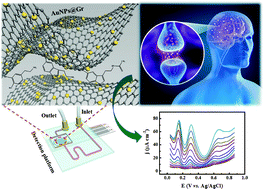A graphene-based electrochemical flow analysis device for simultaneous determination of dopamine, 5-hydroxytryptamine, and melatonin†
Abstract
Developing an accurate, sensitive, and efficient portable device for simultaneous detection of disease-related biomolecules is an attractive challenge for point-of-care testing (POCT). In this work, we introduced a novel graphene-based electrochemical flow analysis device (GEFAD), which combined a 3D-printed flow cell with a three-electrode system based on a gold nanoparticle-modified graphene (AuNPs@Gr) working electrode to simultaneously detect depression-related biomolecules: dopamine (DA), 5-hydroxytrypserotonin (5-HT), and melatonin (MEL). Electrochemical studies showed that the GEFAD had high selectivity and sensitivity in the determination of DA, 5-HT, and MEL with their significant separation peaks. The linear ranges of DA, 5-HT, and MEL were respectively found to be 0.1–70 μM, 0.1–100 μM, and 0.1–150 μM, with the corresponding detection limits of 0.054 μM, 0.071 μM, and 0.087 μM (S/N = 3). In addition, the GEFAD presented a good anti-interference ability and satisfactory reproducibility, and can be used in real calf serum sample analysis. The introduced in-flow electrochemical detection device showed excellent repeatability, less sample consumption, and simple operation, which increases the possibility to implement POCT. This study also proposed a promising application prospect for the development of portable biomolecules detection devices.



 Please wait while we load your content...
Please wait while we load your content...